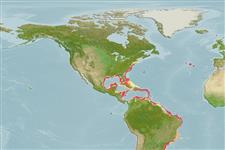Common names from other countries
>
Carangiformes (Jacks) >
Carangidae (Jacks and pompanos) > Naucratinae
Etymology: Seriola: Latin word diminutive with the meaning of a large earthenware pot (Ref. 45335).
More on author: Bloch.
Environment: milieu / climate zone / depth range / distribution range
Ecologia
marino benthopelagico; distribuzione batimetrica 55 - 348 m (Ref. 51158). Subtropical; 43°N - 30°S, 98°W - 15°W
Western Atlantic: Massachusetts, USA to Brazil. Eastern Atlantic: Madeira (Ref. 7097); Turkey (Ref. 95646); eastern Atlantic distribution is uncertain due to past confusion with Seriola carpenteri.
Size / Peso / Age
Maturity: Lm ? range ? - ? cm
Max length : 67.5 cm FL maschio/sesso non determinato; (Ref. 26340); common length : 50.0 cm TL maschio/sesso non determinato; (Ref. 5217); peso massimo pubblicato: 4.6 kg (Ref. 3195)
Spine dorsali (totale) : 9; Raggi dorsali molli (totale) : 28 - 33; Raggi anali molli: 17 - 20.
Adults are benthopelagic near the coasts (Ref. 5217). Smaller juveniles epipelagic in oceanic or offshore neritic waters. Adults feed on squids and fishes (Ref. 4233). Eggs are pelagic (Ref. 4233).
Life cycle and mating behavior
Maturities | Riproduzione | Spawnings | Egg(s) | Fecundities | Larve
Smith-Vaniz, W.F., J.-C. Quéro and M. Desoutter, 1990. Carangidae. p. 729-755. In J.C. Quero, J.C. Hureau, C. Karrer, A. Post and L. Saldanha (eds.) Check-list of the fishes of the eastern tropical Atlantic (CLOFETA). JNICT, Lisbon; SEI, Paris; and UNESCO, Paris. Vol. 2. (Ref. 7097)
IUCN Red List Status (Ref. 130435)
CITES (Ref. 128078)
Not Evaluated
Threat to humans
Reports of ciguatera poisoning (Ref. 30911)
Human uses
Pesca: pesca di sussistenza; Pesce da pesca sportiva: si
Strumenti
Special reports
Download XML
Fonti Internet
Estimates based on models
Preferred temperature (Ref.
115969): 17.7 - 26.5, mean 23.3 (based on 70 cells).
Phylogenetic diversity index (Ref.
82804): PD
50 = 0.5020 [Uniqueness, from 0.5 = low to 2.0 = high].
Bayesian length-weight: a=0.01549 (0.00869 - 0.02760), b=2.95 (2.79 - 3.11), in cm Total Length, based on LWR estimates for this species & (Sub)family-body (Ref.
93245).
Trophic level (Ref.
69278): 4.6 ±0.57 se; based on food items.
Resilienza (Ref.
120179): Medio, tempo minimo di raddoppiamento della popolazione 1.4 - 4.4 anni (Preliminary K or Fecundity.).
Fishing Vulnerability (Ref.
59153): Moderate to high vulnerability (50 of 100).
